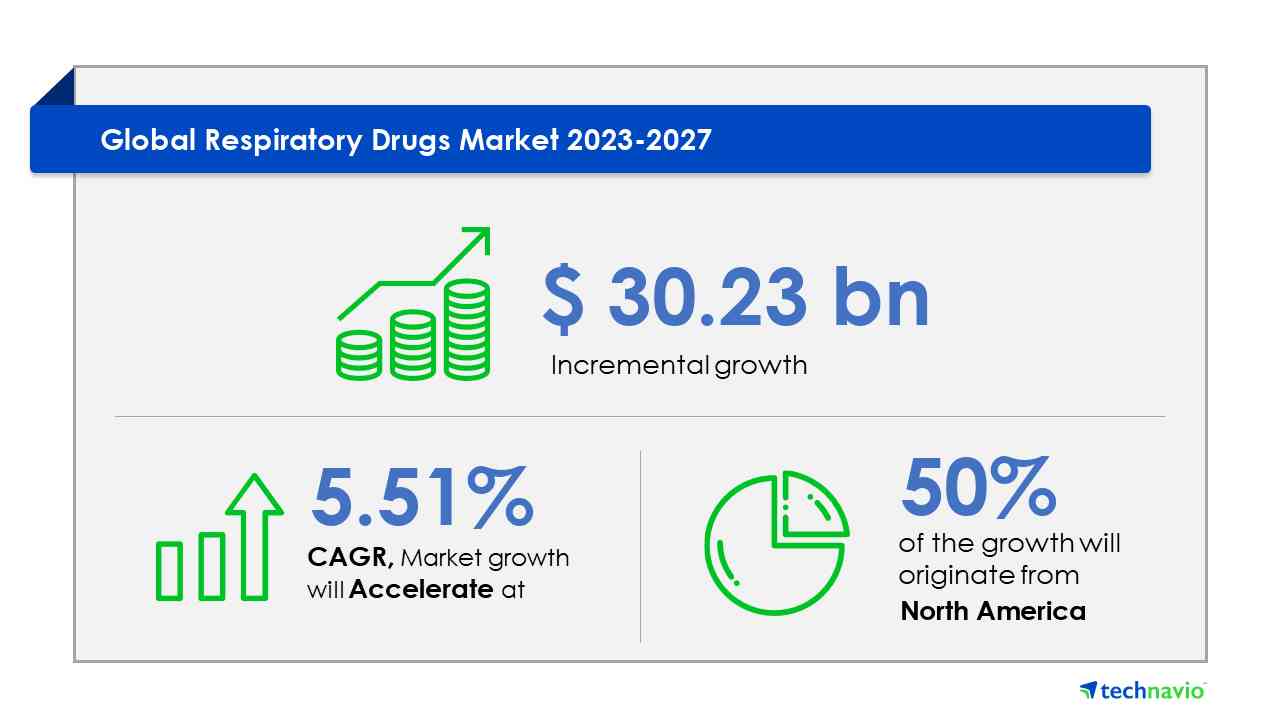Respiratory Drugs Market by Distribution Channel (Hospital pharmacies, Retail pharmacies, Online pharmacies) Type (Asthma, COPD, Allergic rhinitis, Cystic fibrosis, Other respiratory diseases) Geography (North America, Europe, Asia, Rest of World (ROW)) - Global Forecast to 2027
The market size of Respiratory Drugs is estimated to grow by USD 30.23 billion, at a CAGR of 6.38% during the forecast period. In the global respiratory drugs market, respiratory diseases, particularly COPD and asthma, pose significant health challenges. COPD ranks third in Western Europe and fourth globally as a cause of death.Asthma, the most prevalent respiratory disease, affects individuals across age groups, despite the availability of effective therapies. Over the past four decades, the introduction of new classes of drug therapy for respiratory diseases has been limited. Leukotriene receptor antagonists represent a recent addition, but their efficacy in controlling asthma falls short. The need for more effective treatments and new classes of drugs remains a pressing business concern.

Browse market data tables, figures, and in-depth TOC on “Respiratory Drugs Market” by Distribution Channel (Hospital pharmacies, Retail pharmacies, Online pharmacies) Type (Asthma, COPD, Allergic rhinitis, Cystic fibrosis, Other respiratory diseases) Geography (North America, Europe, Asia, Rest of World (ROW)) Global Forecast to 2027.
By Distribution Channel, the Hospital pharmacies segment is projected to dominate the market size in 2024
In the dynamic respiratory drugs market, hospital pharmacies play a pivotal role in procuring and managing essential medications. Collaborating closely with suppliers and pharmaceutical companies, they maintain inventory using advanced systems to ensure a consistent supply. Meticulous documentation is a cornerstone of healthcare, enabling pharmacies to track patient treatment progress and maintain accountability. Pharmacy teams monitor patient responses to prescribed respiratory drugs, communicating any necessary adjustments or modifications to healthcare professionals.By Type, Asthma segment is expected to hold the largest market size for the year 2024
The respiratory drugs market is projected to expand at a steady pace over the forecast period. Key asthma treatments include SYMBICORT, PULMICORT, Relvar Ellipta/Breo Ellipta, ARUNITY ELLIPTA, NUCALA, Seretide/Advair, and XOLAIR. The global asthma population is estimated to reach 450 million by 2030, growing at a rate of 50% per decade. Market leaders AstraZeneca and Novartis are poised to introduce new asthma therapies, capitalizing on the market's significant growth potential. Despite decelerating growth, ongoing innovations are anticipated to mitigate the market's slowdown.North America is forecasted to hold the largest market size by region in 2024
The North American respiratory drugs market is projected to experience substantial growth due to the region's aging demographic. With approximately 8.3% of Americans suffering from asthma, totaling 26 million individuals, the demand for respiratory medications and associated healthcare services is escalating. This trend is particularly prominent in the United States and Canada.The Respiratory Drugs Market growth and forecasting report also includes detailed analyses of the competitive landscape of the market growth and forecasting and information about 20 market companies, including:
- Abbott Laboratories
- AbbVie Inc.
- Aerogen Pharma Ltd.
- AstraZeneca Plc
- Aurobindo Pharma Ltd.
- Boehringer Ingelheim International GmbH
- Celon Pharma SA
- Cipla Ltd.
- F. Hoffmann La Roche Ltd.
- GlaxoSmithKline Plc
- Laboratory Corp. of America Holdings
- Lupin Ltd.
- Medisol Lifescience Pvt. Ltd.
- Merck and Co. Inc.
- Novartis AG
- Sumitomo Pharma Co. Ltd.
- Teva Pharmaceutical Industries Ltd.
- Vertex Pharmaceuticals Inc.
- Wellona Pharma
- Glenmark Pharmaceuticals Ltd.
Research Analysis Overview
The Respiratory Drugs Market encompasses a wide range of pharmaceutical products designed to treat common respiratory infections among the elderly population, as well as chronic conditions such as Asthma and Cystic Fibrosis. Consumer acceptance of these medications is high, driven by the need for effective treatment and improved quality of life. R&D spending in this sector is significant, with a focus on developing novel medications and advanced delivery systems, such as Leukotriene receptor antagonists and Nebulizers.The Respiratory Drugs Market spans various settings, including Home Care, Clinics, E-Commerce, Hospital Pharmacies, and Retail Pharmacies. Smoking population is a growing concern, leading to an increased demand for medications to manage respiratory conditions. The market projection period reflects optimism for continued growth, fueled by the development of new formulations and device types, such as Canister Type and Device Type Nebulizers. Overall, the Respiratory Drugs Market is a dynamic and evolving sector, driven by the need to address the unique challenges of treating respiratory conditions in various patient populations.
Market Research Overview
The Respiratory Drugs Market encompasses a wide range of pharmaceutical products designed to treat various respiratory diseases, including tuberculosis, bronchitis, asthma, and COPD. Key challenges in this market include improper dosing reproducibility, poor formulation stability, high pricing pressures, and regulatory issues. The high vascularization and large surface area of the lungs, coupled with the need for a non-invasive approach, necessitate the development of effective inhalation therapies. Disease types such as chronic bronchitis, asthma, and sleep apnea require combination drugs, including vasodilators, antihistamines, anticholinergics, and inhaled corticosteroids (ICS).The market also caters to specific formulations, such as those for pleural effusion and cystic fibrosis. Rising smoking population and common respiratory infections drive market growth. Digital/smart inhalers and novel medications, like leukotriene receptor antagonists, are projected to dominate the market during the projection period. Pharmacological therapy remains a primary treatment modality, with mortality and incidence rates influencing market dynamics. Reimbursement policies, distribution channels (online pharmacies, retail pharmacies, and hospital pharmacies), and formulation types (coated canisters, plain canisters, and nebulizers) are essential factors shaping market trends. The elderly population and consumer acceptance are also crucial considerations for market success. R&D spending and the rising incidence of respiratory diseases further fuel market growth.




0 Comments